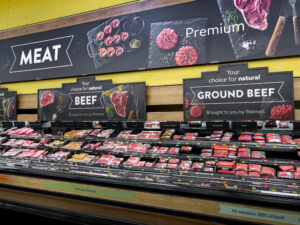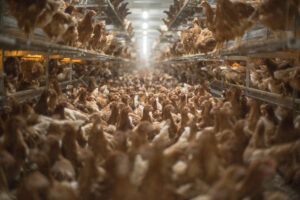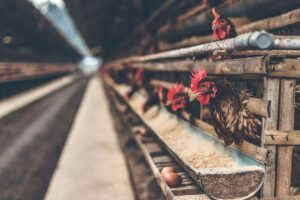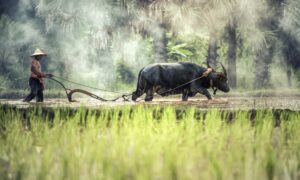Climate Change to Cut Global Food Production, Increase Water Demand
Scientists and other experts are now taking an even dimmer view of the effects of global warming, and believe it will decrease worldwide food production even as demand from an expanding population increases. At the same time, climate change will increase the competition for potable water. And some changes are already occurring.
Two new studies, one leaked, the other released, paint a dire portrait of the human ecosystem as global warming’s impacts cut worldwide food production even as the population increases, driving up the competition for — and likely conflict over — access to potable water.
Together, the two reports suggest the changes will lead to the extinction of an unknown number of species of plants and animals, a shifting of agricultural zones, and human conflict.
The starkest assessment comes in the leaked study by the United Nations’ Intergovernmental Panel on Climate Change, the international panel that shared the 2007 Nobel Peace Prize with Al Gore, and that releases reports every five or six years. According to The New York Times, the newest study, which could change in some of its details before it is released in March, is the starkest yet.
The scientists describe a natural world in turmoil as plants and animals colonize new areas to escape rising temperatures, and warn that many could become extinct.
The warning on the food supply is the sharpest in tone the panel has issued. Its previous report, in 2007, was more hopeful. While it did warn of risks and potential losses in output, particularly in the tropics, that report found that gains in production at higher latitudes would most likely offset the losses and ensure an adequate global supply.
The new tone reflects a large body of research in recent years that has shown how sensitive crops appear to be to heat waves. The recent work also challenges previous assumptions about how much food production could increase in coming decades because of higher carbon dioxide levels in the atmosphere. The gas, though it is the main reason for global warming, also acts as a kind of fertilizer for plants.
, by the nonprofit World Resources Institute, warns that more than a quarter of the planet’s food production comes from “highly water-stressed areas,” according to Salon’s coverage of the study. “That includes half of irrigated cropland, which itself is responsible for 40 percent of the global food supply,” Salon says, defining water stress as a region in which 40 percent or more of the renewable water supply is used up each year.
The WRI sees significant global stresses, which you can assess here using the organization’s interactive Web tool.
The tension between crop production and available water supply is already great, as agriculture currently accounts for more than 70 percent of all human water withdrawal. But the real problem is that this tension is poised to intensify. The 2030 Water Resources Group forecasts that under business-as-usual conditions, water demand will rise 50 percent by 2030. Water supplies, however, will not—and physically cannot—grow in parallel. Agriculture will drive nearly half of that additional demand, because global calorie production needs to increase 69 percent to feed 9.6 billion people by 2050.
The food-water tension won’t just be felt by agriculture, either. Agriculture’s growing thirst will squeeze water availability for municipal use, energy production, and manufacturing. With increasing demand in all sectors, some regions of the world, such as northern China, are already scrambling to find enough water to run their economies.
Governments are grappling with other climate change issues, as well, including how to maintain infrastructure damaged by more cataclysmic storms. President Barack Obama signed an executive order Friday directing federal agencies to begin working with state and local governments to figure out a path forward as the nation confronts more extreme weather, from droughts to floods to hurricanes. The New York Times notes that Obama signed the executive order in part to get around Republicans in Congress who, despite overwhelming evidence and analysis by top scientists, don’t believe global warming stems from the burning of fossil fuels and other human activity.
At the same time, the Times says Obama’s order suggests that the executive branch, at least, believes climate change is here.
But the new push involves a recognition that at the global scale, emissions of heat-trapping gases are still rising, and most scientific experts believe it will be difficult to head off substantial alterations in the climate. They also believe that some of the weather extremes of recent years, such as intense heat waves and heavy downpours, are a foretaste of the kind of changes that will intensify in the future.
The task force of governors and mayors will be asked to identify hurdles in federal policy that are blocking local communities from making smarter decisions. For instance, after flooding from Hurricane Irene destroyed hundreds of road culverts in Vermont, numerous towns there decided to build tougher ones, but were initially stymied by a federal reluctance to pay for such upgrades.
“We really do need to hear directly from the communities and from those who are sort of on the front lines of dealing with the impacts of climate change,” said Nancy Sutley, head of a White House environmental council.
So in the face of cataclysmic climate change, the government forms a committee to make it easier to fix roads. Baby steps, but it’s a start.
—Posted by Scott Martelle.
Your support matters…Independent journalism is under threat and overshadowed by heavily funded mainstream media.
You can help level the playing field. Become a member.
Your tax-deductible contribution keeps us digging beneath the headlines to give you thought-provoking, investigative reporting and analysis that unearths what's really happening- without compromise.
Give today to support our courageous, independent journalists.






You need to be a supporter to comment.
There are currently no responses to this article.
Be the first to respond.